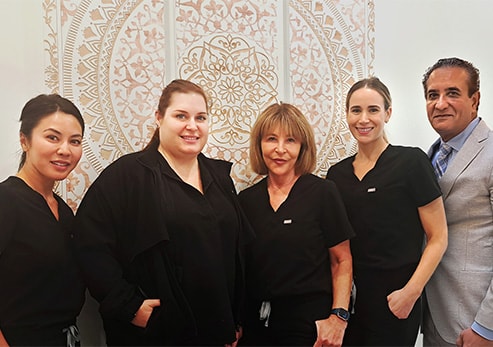Chemical Peels in Oakville, Ontario
 Non-Surgical Treatment
Non-Surgical Treatment Chemical peels help remove the debris from facial skin without extensive treatment time or recovery. While this treatment is often considered an anti-aging option, the procedure is highly versatile in targeting uneven skin tone, acne, clogged pores, dry skin, fine lines, and brown spots. It also treats a number of other conditions, including xanthelasma (fatty deposits around the eyes) and even support post-repair skin smoothing for conditions like torn earlobes.
Chemical peels come in a variety of solutions, enabling us to entirely customize a treatment program to suit individual needs. These peels include Jessners, kojic, trichloroacetic acid (TCA) peels, and salicylic acid. All peels are designed to gently remove superficial layers of skin to reveal fresh, new skin cells underneath without causing significant downtime.
Are you considering a chemical peel in Oakville or Toronto? This guide will tell you all you need to know about chemical peel types, expected results, pricing, and more.

What Is a Chemical Peel?
Many people swear by chemical peels as the secret to radiant skin, from Bollywood A-listers to famous names like Jennifer Aniston and Victoria Beckham. Getting that red-carpet-ready glow involves using a chemical solution to gently remove dead skin cells from the top layers of skin.
With this “controlled damage,” the solution can address both surface-level concerns like fine lines and deeper issues like wrinkles, acne, pigmentation, and melasma. This non-surgical process reveals a fresher, younger-looking complexion while improving texture and tone.
Types of Chemical Peels: Strengths and Expected Downtime
From lunchtime refreshers to deeper resurfacing treatments, chemical peels range from light to deep skin penetration. Factors like pH, concentration, application technique, and current skin condition and sensitivity all influence the level of exfoliation and recovery time.
Here’s how the different peel types compare and what you can expect.
Light (Superficial)
Light chemical peels use various alpha-hydroxy acids and beta-hydroxy acids, such as glycolic, lactic, salicylic, and maleic. This type of peel is ideal for routine maintenance or first-time patients. You’ll walk away with a brighter complexion and smoother skin texture, perfect for a quick glow-up.
- Recovery: Minimal downtime, with slight flaking or redness for a day or two
- Best for: Brightening, mild acne, discolouration, and preventive care
Medium
Medium peels, like Jessner’s solution, go deeper. As the American Society of Plastic Surgeons notes, this peel uses stronger formulations, such as TCA and glycolic acid. It’s designed to remove both the outermost layer (epidermis) and the upper part of the middle layer of skin (dermis)
- Recovery: Redness, peeling, and sensitivity for seven to 10 days
- Best for: Fine lines, dark spots, sun damage, deeper pigmentation, and uneven skin tone
Deep
Deep chemical peels use phenol to penetrate multiple skin layers. This treatment resurfaces skin and corrects severe texture irregularities, deep wrinkles, and prominent pigmentation. To avoid complications, it’s essential to work with an experienced provider like ICLS for this kind of treatment.
- Downtime: More significant peeling and redness for seven to 14 days, with strict aftercare required
- Best for: Advanced signs of aging, deep acne scarring, and tough pigmentation
At your initial visit, we’ll review your skin concerns and goals to customize your treatment plan.
Key Benefits of Chemical Peels for Your Skin
Chemical peels work beneath the surface to improve your skin’s health and function over time, offering long-term benefits. Some of the key advantages include:
- Softer, more even texture: Using gentle exfoliation, peels allow fresh skin cells to rise to the surface, reducing roughness and dry patches.
- Reduction in fine lines and wrinkles: Skin appears smoother and more youthful as collagen production increases and older cells get sloughed away.
- Diminished appearance of sunspots and melasma: Peels can help lighten areas of pigmentation caused by UV damage or hormonal changes. Many people see a more even skin tone.
- Smoother skin surface and smaller-looking pores: By clearing dead skin and buildup, peels refine skin texture and minimize enlarged pores.
- Clearer skin and reduced breakouts: Chemical peels remove debris, oil, and bacteria that can lead to acne. Over time, the treatment can help prevent breakouts and fade post-acne marks.
- Brighter overall complexion: With dull surface layers removed, skin looks fresher, healthier, and more radiant.
Another perk of chemical peels is that they’re non-invasive, with no surgical incisions or extensive downtime required. Most people tolerate them well and recover quickly by following after-care instructions. Additionally, chemical peels are fully customizable. Whether you’re looking for preventive care or more corrective treatment, our team will help you find the right option to rejuvenate your skin safely.
Who Is a Good Candidate for a Chemical Peel?
Curious about whether a chemical peel is right for you? These treatments are highly versatile for different skin types. The guidelines below will give you an idea of whether a chemical peel might be right for you. For a detailed analysis based on your skin concerns, schedule a consultation at ICLS.
Ideal Candidates
You may be a good candidate for a chemical peel if any of the following sound like you:
- You’re in good health and have realistic expectations: While chemical peels can dramatically improve your skin, they work gradually. You’ll see improvements right away, but may require a series of treatments for best results or more significant skin concerns.
- You’re bothered by dullness, rough texture, or uneven tone: Whether you’re dealing with sun damage, mild acne scarring, or early signs of aging, peels can help refine and smooth your complexion.
- You want to address pigmentation issues: Chemical peels can reduce sun spots, melasma, and blotchy areas, creating a more even skin tone.
- Your skin is prone to clogging or breakouts: Peels can clear out clogged pores and help prevent future breakouts by encouraging healthy cell turnover.
- You’re looking for a non-surgical treatment that fits your lifestyle: Peels require little to no downtime. They’re a practical option for people who want visible improvement without stopping their routine.
Chemical peels are suitable for all skin types, but it’s important to choose the right kind for your skin. At ICLS, we’ll work with you to customize the strength and type of peel based on your skin tone, medical history, and skincare goals.
Who Should Avoid Chemical Peels
While chemical peels are safe for many skin types, they’re not necessarily the right fit for everyone. You may need to explore other options or postpone treatment if:
- You have active skin infections, rashes, or open wounds. Chemical peels can worsen irritation and slow healing.
- You are pregnant or breastfeeding. Although some milder treatments may be safe, we recommend waiting until after this stage for more intensive procedures.
- You are currently on prescription acne medications such as isotretinoin (Accutane). These can make your skin more sensitive and prone to scarring.
- You have a history of keloid formation or poor wound healing. These conditions may increase the risk of complications with deeper peels.
- You have very dark skin and are considering a medium or deep peel. We recommend a careful assessment to avoid post-treatment pigmentation changes.
Your skin health and safety come first. During your consultation at ICLS, we’ll take a thorough look at your medical history, skin concerns, and any risk factors. Our experts will ensure your treatment plan is safe, effective, and appropriate for your skin.
The Chemical Peel Process
From your first consultation to post-peel aftercare, we’re with you every step of the way. Here’s what to expect before, during, and after your treatment.
Initial Consultation
Your journey to brighter, more youthful-looking skin begins with a comprehensive consultation. We assess your skin condition, review your medical history, and discuss your goals. This process allows us to match you with the right peel type and strength for your individual needs.
Preparing for Your Peel
We may advise you to take these steps:
- Avoid certain skincare products, like retinoids or exfoliants, for a few days before treatment.
- Use a recommended pre-treatment regimen to prepare the skin.
- Avoid direct sun exposure and tanning beds.
These steps allow for optimal outcomes and reduce the risk of irritation.
During the Treatment
Your provider applies the peel solution in-office and leaves it on the skin for a set amount of time, depending on the type of peel. You may feel a mild tingling, warmth, or stinging sensation. After the peel is neutralized, the last step is applying a calming product and sunscreen.
Post-Treatment Care and Recovery
After a chemical peel, your skin may feel tight, look red, and begin to flake or peel within a few days. Following your provider’s instructions is crucial for proper healing.
- Keep your skin moisturized and protected with SPF.
- Avoid picking or peeling the skin.
- Use only recommended products.
Most patients return to normal activities quickly. However, deeper peels require more downtime and aftercare.
Number of Sessions and Results Longevity
Everyone’s skin is different, and each person has unique goals. For some, just a session or two is enough to freshen up the skin. Deeper pigmentation or scarring may require a series of sessions. Either way, consistency is key for lasting results. Here’s how often to plan your sessions and what kind of long-term outcomes you can expect.
Recommended Session Count
While you may see improvement after a single peel, most patients benefit from a series of treatments. The number of sessions depends on the skin concern and peel type.
- Light peel: Three to six sessions spaced three to four weeks apart
- Medium peel: Two to three sessions spaced two to three months apart
- Deep peel: Often a one-time treatment to the intensity
How Long Do Results Last?
Results from light peels can last several weeks. Medium and deep peels offer results lasting several months to years. Pair your peel with good at-home skincare and sun protection for even better results.
Cost of Chemical Peels in Oakville & Toronto
Your skin is unique, and so is your treatment plan. Pricing varies based on the type of peel and the treatment area. Here’s a breakdown to help you plan.
Kojic/Jessner’s Peels
- Face: $175 per session
- Face/Neck: $315 per session
- Face/Neck/Chest: $475 per session
- Back: $265 per session
- Face/Back: $420 per session
TCA Peel
- $265 per session
The number of sessions required depends on your skin’s needs and desired results. Contact ICLS to explore which chemical peel might be right for you.
Choosing a Chemical Peel Clinic
A chemical peel is only as good as the person performing it. Working with an experienced provider is essential for safe, satisfying results. Here’s what to look for in a chemical peel provider in Oakville or Toronto.
Expertise and Certification
At ICLS, all chemical peels take place under the supervision of board-certified dermatologists like Dr. Sheetal Sapra and highly trained nurses. We ensure the highest standard of care and adhere to strict protocols.
Clinic Reputation and Technology
Our clinic combines advanced techniques, proven products, and personalized care. With decades of experience, we deliver safe and effective results and have a strong track record of success.
As one patient who had struggled with acne and hyperpigmentation states, “Dr. Sapra’s multi-pronged plan has been a pain-free, easy-to-follow, and highly effective treatment. ICLS is a team of professionals who actively listen to patients and address concerns and complaints, and I absolutely cannot recommend them enough!”
Featured Video
Frequently Asked Questions
-
Is microdermabrasion better than a chemical peel?
Both treatments exfoliate the skin but work in different ways. Chemical peels use active ingredients to dissolve damaged skin cells; microdermabrasion uses mechanical abrasion. Your provider can help determine which treatment may be more effective based on your skin needs.
-
Can I combine chemical peels with other treatments?
Yes. Many patients combine peels with treatments like Broadband Light Therapy. Combination therapy often allows for optimal, lasting outcomes.
-
Will a chemical peel make my skin more sensitive to the sun permanently?
No. While your skin will be temporarily more sensitive after a peel, this isn’t permanent. Daily sunscreen use is essential for all patients.
-
Can chemical peels help with hyperpigmentation on darker skin tones?
Yes, but careful selection and professional application are key. At ICLS, we tailor peels to each person’s skin tone to minimize risks and optimize results.
-
What kind of results can I expect after my first peel?
Results may be noticeable after just one session. Most patients notice brighter, smoother skin within a week. Full benefits are built over a series of treatments, especially for concerns such as scarring or pigmentation.
-
How much should I expect my skin to peel after a treatment?
It is impossible to know in advance how much peeling will occur, but if you note the relative amount of peeling that occurs after each session, future peels can be adjusted to suit your needs.
-
How often should I have a chemical peel?
We recommend repeat treatments spaced approximately four to six weeks apart, as the skin will continue to build up with dead cells over a 30- to 45-day cycle.
Why Choose ICLS for Chemical Peels Treatment?
Patients from Oakville and the Greater Toronto Area, including Toronto, Mississauga, Burlington, and Hamilton, choose ICLS for Chemical Peels due to Dr. Sapra’s extensive experience and our team’s dedication to patient satisfaction. We provide personalized treatment plans to ensure effective and lasting results.
Schedule a consultation to rejuvenate your skin with our Chemical Peel services.


Our Nurses & Specialist
At ICLS, you will be under the care of some of Canada’s most experienced registered nurses. ICLS is one of the only practices in the country (maybe even the world!) to employ only registered nurses to deliver treatments. Our all-female nursing staff consists of hard-working, internationally-trained medical professionals.
Our nurses perform your treatment under our medical director, Dr. Sheetal Sapra, who is a top dermatologist and pioneer of new technologies aimed at improving the lives and looks of his patients. Dr. Sapra has practiced medical dermatology for more than 35 years and has made significant contributions to the field.
